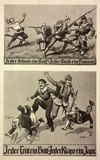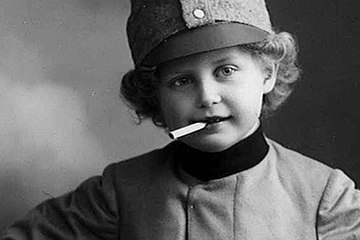Friend and foe – guilt and innocence in First World War propaganda
The propaganda produced by the warring states exhibited few distinctive national traits. It conveyed similar messages about the progress and aims of the war, images of the enemy and national identity, varying according to the country of origin.
In Britain as in France, the German Empire and the Habsburg Monarchy, propaganda radicalized the meaning and legitimation of the war. The rabble-rousing messages brutalized collective imaginations, reinforced enemy stereotypes and made a compromise settlement between the hostile states unthinkable.
All the states involved in the war blamed the enemy for the war, stylizing it as the aggressor and themselves as the defenders of justice. This victimization allowed them to represent their prosecution of the war as a legitimate battle for peace, while painting the enemy’s actions as a violation of international law. The reciprocal assignment of blame led to the hardening of the stereotypes of enmity only a few weeks after the outbreak of war, and these basic accusations were conveyed in unchanging messages.
On the Allied side these accusations of guilt were accompanied by the denigration of the Central Powers as ‘Huns’ and ‘barbarians’, against whom the Allies were waging a ‘crusade against evil’, an argument that ran like a thread through the atrocity propaganda against Germany. As the principal enemy, Germany and its soldiers, standing in for the Central Powers, were accused of sadism, brutality and sexual violence. Anti-German propaganda was supported by American sociologists who opined that Germany’s technological and industrial progress stood in inverse contrast to its politico-cultural backwardness – a fatal interaction that they claimed was demonstrated by Germany’s brutal conduct of the war.
The Habsburg Monarchy deployed atrocity propaganda against Russia, issuing unceasing reports of rapes, extreme acts of violence and massacres of civilians. By turn, Austria-Hungary’s projection of its identity used art to convey its special culture, demonstrating its supposed superiority as a nation.
The fact that the basic lines of the propaganda campaigns on all sides were able to establish themselves so quickly was connected with the rivalries between the Great Powers that had preceded the war. Propaganda drew on existing stereotypes of enmity, falling on fertile soil in the general population. It was also suited as a medium of national self-articulation, the purpose of which was to bolster the nation’s sense of self-esteem by dissociation from and denigration of the enemy Other.
Translation: Sophie Kidd
Mousser, Jaouad: Die Konstruktion des Feindes. Feinde und Feindbilder in zwei Jahrhundertkriegen, Saarbrücken 2007
Jeismann, Michael: Propaganda, in: Hirschfeld, Gerhard/Krumeich, Gerd/Renz, Irene (Hrsg.), Enzyklopädie Erster Weltkrieg, Paderborn/München/Wien/Zürich 2009, 198-209
Johler, Reinhard: Zwischen Krieg und Frieden. Die Konstruktion des Feindes. Eine deutsch-französische Tagung, Tübingen 2009
-
Chapters
- Propaganda: psychological warfare in the First World War
- The battle for hearts and minds.
- Friend and foe – guilt and innocence in First World War propaganda
- “Let your hearts beat for God and your fists beat the enemy”
- The First World War as reflected in the distortions of caricature
- The war on the wall
- Truth from the clouds
- The Emperor’s Voice
- Tones and Sounds







